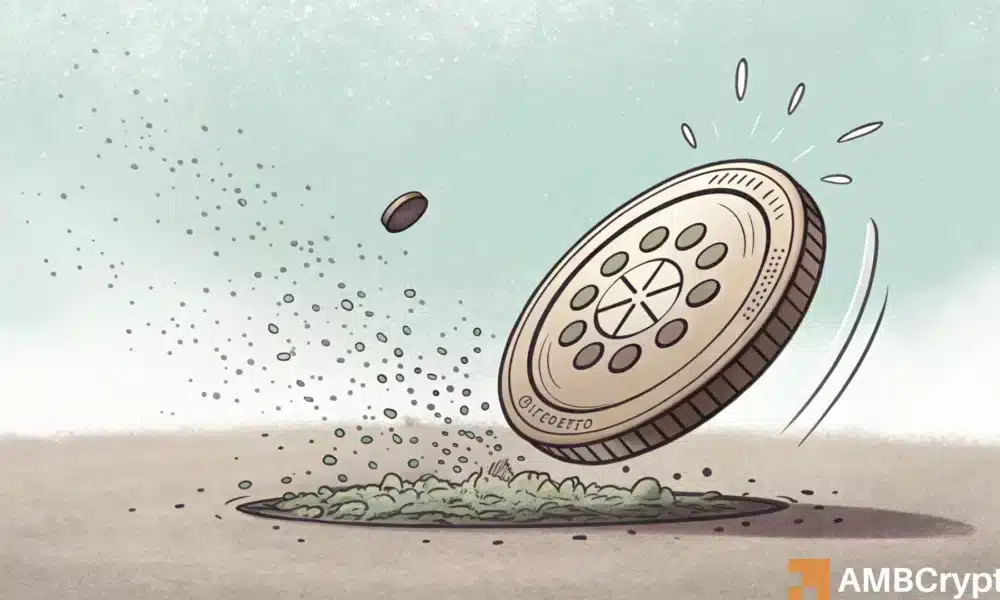Cardano’s Market Dynamics: Rising Risks and Deteriorating Fundamentals
Cardano (ADA) has recently experienced a notable bounce back from its $0.50 low, showcasing a resilient recovery of 28%. However, the landscape for ADA is becoming increasingly complex as it faces mounting pressure from deteriorating on-chain fundamentals. With its market capitalization slipping from eighth to tenth place, the sentiment surrounding Cardano has taken a significant hit. This decline isn’t just an external challenge; it signals a worrying trend internally, as the FOMO (Fear of Missing Out) premium associated with Cardano is diminishing. Investors are left to ponder whether ADA is on the verge of entering a broader distribution phase, highlighting the intricacies of investor psychology and market dynamics.
One of the most pressing indicators of Cardano’s current struggle is its on-chain performance. The network’s throughput has plummeted to $1.35 billion, a stark decrease from a peak of $7.80 billion observed on April 7th. This regression has drawn parallels to pre-election market levels and indicates that Cardano is losing ground to formidable rivals such as Tron (TRX) and Dogecoin (DOGE). Rather than being a victim of external market forces, the decline reflects significant internal weaknesses, including a lack of fresh liquidity flowing into the ecosystem. As Cardano’s structural support erodes, the pressure intensifies on the network’s long-term holders (LTHs) to reassess their positions amidst evolving market conditions.
In light of these developments, it’s crucial to analyze the behavior of Cardano’s LTHs. Presently, the market value of ADA is comparable to levels last seen five months ago in November. This situation puts many LTHs—who entered the market during a rally spurred by the elections—at their cost basis, with a considerable number either breaking even or facing unrealized losses. The critical question arises: Are these long-term holders beginning to lose faith in a potential rebound, or is this merely a temporary shakeout before reaccumulation commences? Understanding LTH sentiment is fundamental as it directly influences the future trajectory of ADA.
Key metrics provide insights into potential distribution risks for Cardano. The Mean Dollar Invested Age (MDIA) for a 180-day period, which captures the average age of capital invested in ADA, has seen a notable downtrend since mid-March. This trend coincides with Cardano’s inability to sustain critical resistance levels, indicating that older coins are either being sold or repositioned within the market. The decrease in MDIA raises alarms about potential distribution behavior among long-term holders, potentially signaling a shift in market sentiment that could precede further sell-offs.
Adding to the narrative of rising sell-side pressure is the spike in a metric known as Age Consumed, which tracks the movement of dormant coins. Elevated levels of this metric suggest that long-held assets are being reactivated, indicative of strategic offloading by LTHs. The convergence of declining MDIA along with surging Age Consumed constitutes a compelling signal of heightened distribution activity. With older coins re-entering the market and a lack of robust accumulation reflected in Cardano’s network performance, the upcoming challenge lies in maintaining its critical support level at $0.63. A breakdown below this threshold could catalyze deeper corrections, particularly if the recently observed market rebound fails to hold.
In conclusion, Cardano faces profound challenges as it navigates its current market position. The fading of its FOMO premium, coupled with deteriorating fundamentals and changing investor dynamics, suggests that ADA is at a pivotal juncture. Long-term holders are caught between potential losses and the hope for a market resurgence, while critical metrics point toward an emerging phase of distribution. Stakeholders and investors must closely monitor these developments, as they could significantly impact Cardano’s trajectory in the near future. The evolving dynamics of ADA not only reflect the complexities of the cryptocurrency market but also underscore the fluctuating confidence of its investor base.


